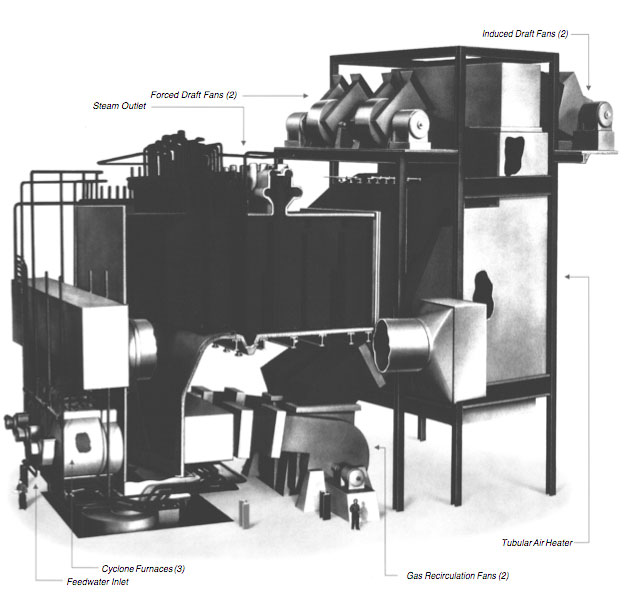#228 Philo 6 Steam-Electric Generating Unit
1957
The world's first commercial supercritical steam-electric generating unit
Philo Unit 6 was the world's first supercritical-pressure steam-electric generating unit to operate commercially. The mechanical engineering innovations represented by Philo 6 significantly advanced the thermal efficiency of power generation, thereby greatly reducing its production cost. Its performance proved that introduction of higher steam pressure and higher steam temperature to power generation-combined with use of a double-reheat cycle-indeed could produce new levels of thermal efficiency, approaching 40 percent. At that time, the national average thermal efficiency of all fossil-fueled power plants was 29.9 percent. Experience gained from the engineering, design, construction, and operation of Philo 6 provided a firm engineering basis for many larger, efficient generating units that were to follow.
Both the feedwater inlet pressure of 5,500 pounds per square inch (psi) [37.9 mega Pascal (MPa)] and the turbine throttle pressure of 4,500 psi (31 MPa) constituted new "highs" in their respective classes and were almost double the steam pressure previously utilized for power production. The main steam temperature of 1,150 F (621 C) was 50 F (27.8 C) higher than economically achievable with then-existing technologies. The use of a double-reheat cycle [1,050 F (566 C) first reheat and 1,00 F (5338 C) second reheat] was a major innovation in the engineering of steam-electric power plants. The cyclone furnace design, integrated unit controls, feedwater chemical control, steam generator startup system, and feed-pump design were all uniquely developed for this pioneering unit.
The unit's steam generator, designed and built by Babcock & Wilcox, was rated at 675,000 pounds per hour (8 5 Kg per second) at 4,500 psi (31 MPa) and 1,150 F (621 C) with a feedwater temperature of 525 F (274 C). The unit's turbine-generator, designed and built by the General Electric Co., was a 3600-rpm, tandem-compound, double-flow turbine driving a 156,250 kva hydrogen-cooled generator.
The next supercritical-pressure unit to enter commercial service in the United States, after Philo 6, was Philadelphia Electric Company's Eddystone Unit 1 in February 1960.
Significant dates for Philo 6:
1952-1953 - American Gas and Electric Co. (predecessor to AEP) conducted a technical, design and economic study of future generating capacity; study culminated in decision to build a 125-MW unit, exploiting steam at supercritical conditions in a double-reheat cycle
May 1953 - AG&E entered into agreements with the General Electric Company and the Babcock & Wilcox Company to build Philo Unit 6
1953 - 1957 - Engineering, design and construction of Philo 6
May 20, 1957 - Unit began delivering electric power to customers
Aug. 1, 1957 - Philo 6, the first supercritical-pressure steam-electric generating unit, was declared to be in commercial operation
Jan. 1. 1979 - Philo 6 was retired from commercial operation; the unit along with the entire Philo Power Plant, was subsequently dismantled in 1984
Landmark Location
American Electric Power
1 Riverside Plaza
Columbus, OH 43215-2372
AEP: http://www.aep.com
Owner or plaque location, if different than above
The plant was near Zanesville, Ohio, and was retired in 1979 and demolished in 1984; the plaque is in front of AEP headquarters in Columbus.
Ceremony Notes
Plaque presented on Aug. 7 by Past President Donald Zwiep; was attended by 150; sponsored by Central Ohio Section; covered by the Zanesville Times, Power Generation and World Generation magazines.

